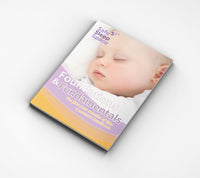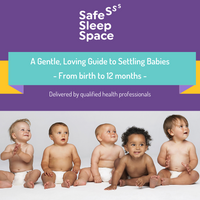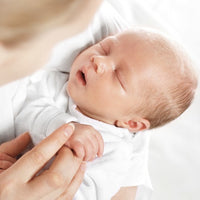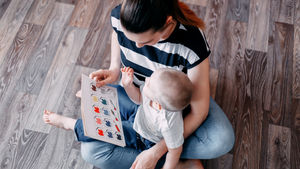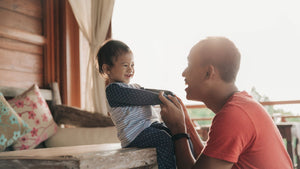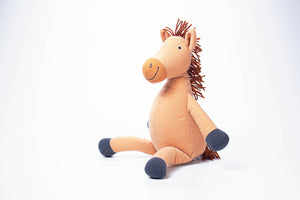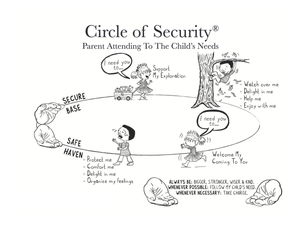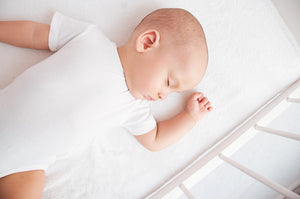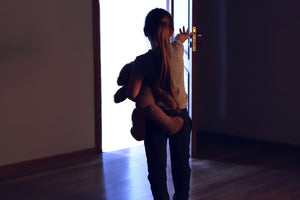Weighted blankets – are not safe for babies and young children

Key points
- There is no consistent evidence that weighted blankets or weighted sleeping bags improve children’s sleep.
- Weighted blankets are unsafe and stop the normal expansion of a child’s chest when breathing.
- Weighed blankets are too heavy for small children, who may not be able to free themselves from underneath.
What is a weighted blanket?
Weighted blankets are also called ‘calming’ or ‘sensory’ blankets and are often marketed as a sleep aid for babies and young children. They have ‘pockets’ sewn into them which can be filled with a dense compound which makes them heavy.
Advertisers claim weighted blankets assist the child to go to sleep because they boost a sense of security and help them to calm. Some also report that weighted blankets help to supply a type of deep tissue massage or therapy, which increases relaxing hormones in the brain.
However, there is no evidence or proof that any of these claims are accurate. In fact, weighted blankets can be very unsafe and tragically, there have been babies and children who have died when being covered by a weighted blanket during their sleep.
What’s in a weighted blanket?
Weighted blankets are different to normal blankets because they contain pockets which are filled with a heavy material. Sand, beads filled with silicone; polystyrene or steel shot, pebbles, grain and even micro glass beads are used to evenly fill the pockets, making the blanket heavy and dense.
According to manufacturers, it’s important that whatever filling is used is small enough not to be rigid and to mould around the child’s body. Weighted blankets tend to be more pliable than normal blankets. When placed against the body, they follow the outline of whatever is underneath them.
Why are weighted blankets unsafe?
There has been a huge amount of research into babies’ and children’s sleep. Making sure their sleeping environment is safe helps to reduce the risk factors for Sudden Unexplained Death in Infancy (SUDI). Babies and young children are vulnerable when they’re sleeping, especially in relation to their airways.
The smaller the child, the smaller and more compressible their airways. Their chest wall is also more easily compressed and they have less stamina with their respiratory (breathing) capacity than older children and adults.
Any pressure against a baby’s chest can prevent their lungs filling with air and for their chest to expand as it needs to. Compression also impacts a baby’s ability to move their abdominal wall to allow for normal expansion when breathing.
It’s fair to say that many weighted blanket manufacturers recommend they are not used for children aged less than 4 years. However, there is insufficient evidence to prove they are helpful or safe for any age group and experts advise against using them.
The pressure from a weighted blanket stops the normal expansion of a baby’s chest and abdomen when they are breathing.
Are there any benefits to using a weighted blanket?
In the last few years, weighted blankets have become a more popular item in many households, especially during the winter months. But what may be a reasonable option for adults to keep warm and cosy, is another thing entirely for babies and young children.
Small children don’t have the ability to roll and move freely from under bedclothes and blankets of any design. Weighted blankets are especially unsafe because they inhibit a child from moving.
Where did the idea of weighted blankets come from?
Weighted blankets were originally recommended by some occupational therapists as a therapy aid for children with sensory processing disorders. It was felt that heavier blankets initiated a calming response and helped to ‘contain’ the child’s responses and to calm them when their nervous system was over-aroused.
As is often the case, the opportunity for a marketing opportunity opened up. Before child health and safety experts could make a proper assessment, weighted blankets of every shape, size and colour flooded the market. Claims of weighted blankets calming the nervous system, soothing an unsettled child and relieving symptoms of anxiety with unqualified testimonies have become common on manufacturer’s websites.
The truth is that there is no proven evidence that weighted blankets do anything beneficial. In fact, they can be dangerous to use for babies and young children.
What can I do to help keep my baby safe when they’re sleeping?
Red Nose recommends 6 key steps in helping to reduce the risk of sudden infant death.
- Always place your baby to sleep on their back, with their feet at the end of the cot.
- Keep your baby’s face and head uncovered.
- Keep your baby smoke free, before and after birth.
- Make sure your baby is in a safe sleeping environment, day and night. Make sure your baby is sleeping in a safe cot which meets the Australian Standards and sleeping on a safe mattress with safe bedding. Use a safe sleeping bag for your baby which has a fitted neck, fitted armholes and no hood.
- Sleep your baby in your room for the first 6-12 months.
- Breastfeed your baby.
Red nose also recommends not using quilts, blankets, doonas, pillows, bumpers, sheepskins or other loose items in your baby’s cot - weighted blankets certainly fall into this category. Not only are they a type of blanket, but by their nature, they’re heavy.
Babies can’t remove themselves from under weighted blankets and if they roll onto their tummy, a weighted blanket is particularly unsafe.
Speak with your Child Health Nurse or check Safe Sleep Space for more information on safe sleeping.
About the Author:
Written for Safe Sleep Space by Jane Barry. Jane has qualifications in general, paediatric, immunisation, midwifery and child health nursing. She holds a Bachelor Degree in Applied Science (Nursing) and has almost 35 years specialist experience in child health nursing. She is a member of a number of professionally affiliated organisations including AHPRA, The Australasian Medical Writer’s Association and Australian College of Children and Young People’s Nurses.
References
Weighted Baby Sleep Sack Warning | Red Nose Australia
Safety advice for carers about weighted blankets | Department for Child Protection
Weighted blankets – are they safe for kids or during pregnancy? | Pregnancy Birth and Baby
Weighted blankets are not safe for babies | Red Nose Australia
